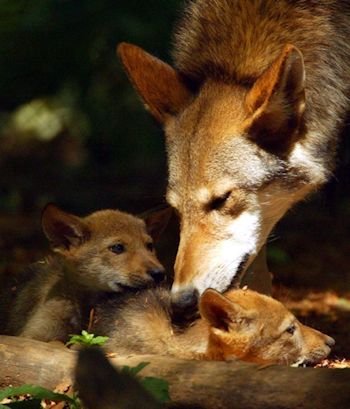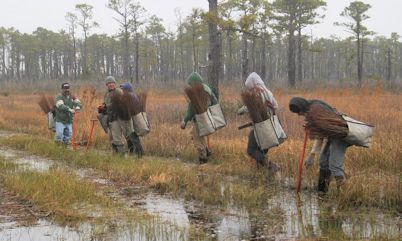 You can explore the Alligator River National Wildlife Refuge by launching a canoe or kayak into Mill Tail Creek, above, or hiking along Sandy Ridge Trail. Photos: Kip Tabb |
EAST LAKE — On the western side of the sounds that separate mainland North Carolina from the Outer Banks lies the Alligator River National Wildlife Refuge, a vast wilderness of swamp, pocosin and forest that nurtures an environment of extraordinary diversity.
There are a number of roads that lead into the refuge, most of them interconnecting. Flat, fairly straight and dusty, Buffalo City Road is much like the others except that it dead ends at a beautiful kayak and canoe launch on Mill Tail Creek. To the left of the turnaround there’s a smooth, easy to hike trail heading south, a trail that looks as though it may at one time have been a railroad bed to take the lumber that was harvested from the forest.
Supporter Spotlight
There was once a small city here — Buffalo City — a logging town from the 1870s to the 1920s and when the logging gave out, the residents turned to moonshining during Prohibition.
There is nothing left of the town; the surrounding swamp, pocosin and forest have reclaimed the land and Buffalo City is now the stuff of legend.
Alligator River National Wildlife Refuge is almost 154,000 acres and is one of the largest wildlife refuges on the East Coast. Now in its 30th year, it has become an important part of efforts to retain the diversity of a pocosin environment.
Alligator River became a national wildlife refuge almost by accident.
In the 1970s and ‘80s, the land that it occupies was being developed for corporate farming by Prulean Farms, a joint effort among a number of large corporations. A drop in crop prices, loss of land value during the 1980 recession and public opposition to a proposal to ditch thousands of acres of wetlands for farming created a scenario where the company felt it would be better to donate the land than to own it.
Supporter Spotlight
Bonnie Strawser, the visitor services manager, has been with the refuge since it was founded and she recalls the surprise when the land was donated to the wildlife refuge system. “We knew this chunk of land was being donated to conservation,” she said. “They were looking at either ownership by the state or management by the state.”
 Breeding pairs of endangered red wolves were introduced into the refuge in 1987. There are now about 100. Photo: U.S. Fish & Wildlife Service If You GoThe U.S. Fish and Wildlife Service administers the Alligator River refuge jointly with the Pea Island National Wildlife Refuge on the Outer Banks. The Visitor Center is on old U.S. 64 about two miles past downtown Manteo on the opposite side of the road from the Lost Colony and Fort Raleigh. The address is 100 Conservation Way. The refuge itself is on the mainland in Dare County. Click here for directions. To strike out on your own, the refuge offers a number of hiking, driving and paddling trails that will give you a chance to the see the vast diversity of animals. Guided canoe tours and a tram rides will also be offered in the fall. Look here for details. Rangers will also take you out in the refuge at dusk to listen for howling red wolves. Three such excursions are planned in the fall, including a “full moon howl” on Nov. 15. All are free and no registration is required. Many events for the annual Wings Over Water Wildlife Festival, Oct. 21-25, are scheduled in the refuge. |
When the donation was discussed with the IRS, however, a different strategy became necessary. “Then the ruling came back that since they had approved the prior donation, that since it had come out of the federal coffers, it has to go into the federal coffers,” she said. “With just a few weeks’ notice we found out we were getting this refuge.”
At the time it was considered a wasteland. “Pocosin wetlands were not something anyone had dealt with,” Strawser recalled. “We (wildlife refuge managers) were used to fresh water marshes. Saltwater marshes. Those kind of marshes.”
Refuge biologist Dennis Stewart has been at the Alligator River since 1994, but did field work on the land for environmental studies before coming to the refuge. The research he did at the time confirmed the value of the refuge. “Early on people didn’t understand the significance of those habitat types for migratory birds,” he said. “But as we were collecting our data we were learning more and more about how valuable it is.”
The value of the refuge became quickly apparent to wildlife managers. One of the largest protected environments along the East Coast, it was the ideal location for an audacious experiment.
The red wolf had been officially declared extinct in the wild, but a captive breeding program kept the species alive and genetically viable. “Here locally we didn’t know about the red wolf at all,” Strawser said. “We didn’t know that the endangered species biologists had pie eyes over this huge piece of landscape that was so rare in the East.”
In 1987 breeding pairs of red wolves were brought to Alligator River. “The service took the bold step of saying as an agency, ‘This Alligator River National Wildlife Refuge is within the historic range of this highly endangered species. This place might be the place to establish an experimental population to see if we can reintroduce a population here,’” refuge manager Mike Bryant said.
“We still have red wolves. So that’s a success,” he added.
Most of the wolves introduced into Alligator River continue to call it home. Estimates put the population at around 100, a population that seems larger — and closer — during the wolf howlings held throughout the year.
Red wolves are just one of a large number of species that roam Alligator River. “We have a very robust bear population out there,” Bryant said.
There is also a thriving population of alligators. “One question I get asked probably more commonly than any other question is, ‘Do you really have alligators there?’” Stewart said. “And the answer is ‘Yes, we have alligators.’ We are at the northern range of the alligators here.”
There have been some surprises as biologists have inventoried the refuge. “An interesting species is the red cockaded woodpecker,” Stewart said. Before the discovery of the woodpecker in Alligator River, it was thought they lived only in longleaf pine forests. “Somehow the red cockaded woodpecker can survive in the pond pine pocosin, which is completely different than the longleaf pine habitat.”
In addition to wildlife management, Alligator River is also in the forefront of efforts to study the effects of sea-level rise. Because of its history, geography and location, the refuge is one the first locations to feel the effects of rising seas.
When the land was being cleared for farming, ditches and canals were dug to drain the fields. Otherwise the high water table would make it impossible to grow crops. The Nature Conservancy saw an opportunity to develop an experimental model to see if the effects of sea-level rise can be mitigated.
 Volunteers plant trees in the refuge in a sea-level rise experiment. Photo: John Warner, the Nature Conservancy |
“We’ve got this big chunk of land that’s so low in the landscape as the sea rises we’re losing land,” Bryant explained. “We’re also getting a big change in the plant community from forest to marsh at a very rapid rate. This rate of change is not normal.”
“When you look at maybe 90 or 95 percent of the refuge, it’s under two-feet elevation,” Stewart said. “So a sea-level rise of a half inch can wet out a large area. Wherever you have a canal, you get this wedge of change where the salt water encroaches.”
Working with the Nature Conservancy, Stewart has devised a control system that may give wildlife managers a tool to slow the effects of saltwater encroachment. “I refer to it as a climate adaptation project that we have been working on jointly with the Nature Conservancy,” he said. “We’ve had a multifaceted project to try to return it to a more natural process so it doesn’t go as far inland as it would through the canal system. We have a . . . water control structure that has check valves on the downstream end. They close when the water is coming upstream so the salt water can’t go upstream.”
The project also includes water control systems to spread fresh water during heavy rains and experiments with native plants that can best handle saltwater intrusion.
The experiments are part of a mandate to preserve a wilderness as something to be treasured. “We’re an agency of people who are really passionate about wildlife,” Bryant said. “And understanding that you don’t have wildlife without habitat if they’re going to be in the wild. The reason for establishing a wildlife refuge is they need a place to live as wild things.”







